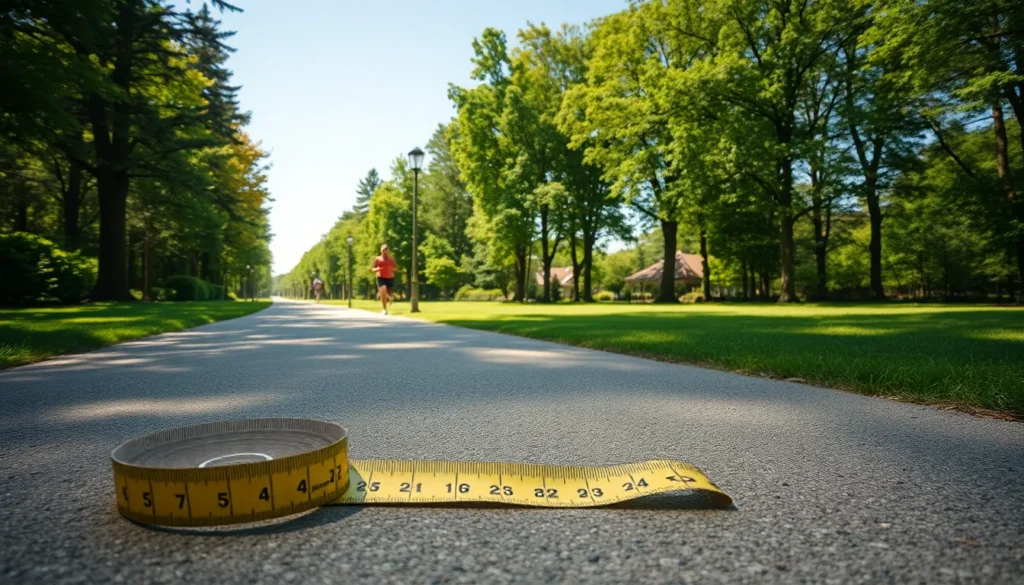Table of Contents
ToggleEver found yourself in a heated debate about how many feet are in a mile? If so, you’re not alone. It’s one of those questions that can stump even the most seasoned trivia buffs. Whether you’re planning a long hike or just trying to impress friends at a party, knowing this simple conversion can make you the star of the show.
A mile is a whopping 5,280 feet. Yes, you read that right—5,280! That’s about the length of 1,760 yards, or roughly 25 laps around a standard track. So next time someone asks, you can confidently drop that knowledge bomb and watch their jaws drop. Who knew math could be so entertaining?
Understanding Measurement Units
Measurement units provide a standard way to quantify distance, area, volume, and other attributes. Feet and miles serve specific purposes within this framework. One mile equals 5,280 feet, confirming the precise measurement used primarily in the United States.
Different contexts utilize these units effectively. Transportation, education, and various activities depend on accurate conversions. For example, runners often use miles to gauge their distance, while construction projects frequently apply feet for measurements.
In addition to feet and miles, other units exist for measuring distance. Meters and kilometers are common in countries using the metric system. Understanding these conversions can facilitate global communication and collaboration.
Conversion factors simplify the process of transforming one measurement to another. A basic formula is handy when converting between feet and miles. When dividing feet by 5,280, the result yields miles.
Helpful tools assist in conversion tasks. Online calculators and conversion apps quickly provide answers for complex calculations. Familiarity with these tools enhances accuracy when working with measurements.
Overall, grasping different measurement units, including feet and miles, enhances knowledge and practicality. Clear understanding aids in various scenarios, making day-to-day activities more manageable. Whether hiking, driving, or planning a workout routine, knowing how these units relate matters.
The Basics of Miles and Feet

A mile and a foot are essential units of measurement in distance. Understanding these units aids in various activities, from athletics to everyday planning.
Definition of a Mile
A mile equals 5,280 feet and commonly serves as a measure for longer distances. Primarily used in the United States, this unit represents great lengths in roadways and races. The unit’s origins trace back to ancient Roman measurements, specifically the mille passus, which indicated 1,000 paces. Various contexts utilize miles, including driving, running, and hiking. For instance, races often use miles to specify course lengths. When planning travel, grasping this measurement ensures accurate distance assessments, enhancing overall navigation.
Definition of a Foot
A foot comprises 12 inches and represents a smaller distance measurement. This unit originates from human anatomy, reflecting the average length of a foot. Commonly, people use feet in contexts like home construction, where precise measurements inform design and building. This unit plays a vital role in various applications, including athletic fields where dimensions rely heavily on feet. In day-to-day life, individuals often reference feet when discussing heights and distances, making it a familiar part of American measurements. Overall, the foot allows for quick understanding and communication of smaller distances.
Converting Miles to Feet
Converting miles to feet involves straightforward calculations. One mile consistently equals 5,280 feet, making conversions easy.
Calculation Method
To convert miles into feet, multiply the number of miles by 5,280. For example, traveling 2 miles means calculating 2 times 5,280, resulting in 10,560 feet. This method applies to any distance in miles, facilitating quick conversions during various activities like running or planning a road trip.
Examples of Conversion
Different scenarios illustrate mile to foot conversions. Running a marathon covers 26.2 miles, which translates to 138,336 feet when multiplied by 5,280. A simple trip of 3 miles equals 15,840 feet. This approach can clarify distances when measuring hikes or navigating routes, essential for accurate planning or comparisons with other measurements.
Practical Applications
Understanding how many feet are in a mile deepens comprehension of different measurement systems. Practical applications arise in various settings, making this knowledge essential.
Everyday Scenarios
Walking or jogging often involves distances measured in miles. A 2-mile walk equals 10,560 feet, useful for tracking fitness goals. Parents planning a road trip might find distances in miles, like a 15-mile drive, which translates to 79,200 feet. Familiarity with these conversions enhances navigation and timing for activities like running events or hikes. Knowing a mile’s length in feet also aids in home improvement tasks when distances need precise measurements.
Importance in Various Fields
The construction industry relies on accurate distance measurements. Architects and builders use miles and feet to plan layouts and identify site dimensions. Transportation relies heavily on this understanding, with vehicles often displaying speed limits in miles per hour. Navigational systems calculate distances in miles, influencing travel routes. Additionally, distance running events are commonly measured in miles, allowing athletes to track performance effectively. Multiple sectors depend on this knowledge, highlighting its significance in everyday life and professional contexts.
Understanding the conversion of miles to feet is essential for navigating various activities and tasks. With one mile equaling 5,280 feet it’s a straightforward calculation that can enhance planning for fitness goals or road trips.
This knowledge not only aids in personal endeavors but also plays a crucial role in fields like construction and transportation. Grasping these measurement units makes everyday life more manageable and efficient. Embracing this mathematical fact can lead to better preparation and a deeper appreciation for the distances we encounter daily.




